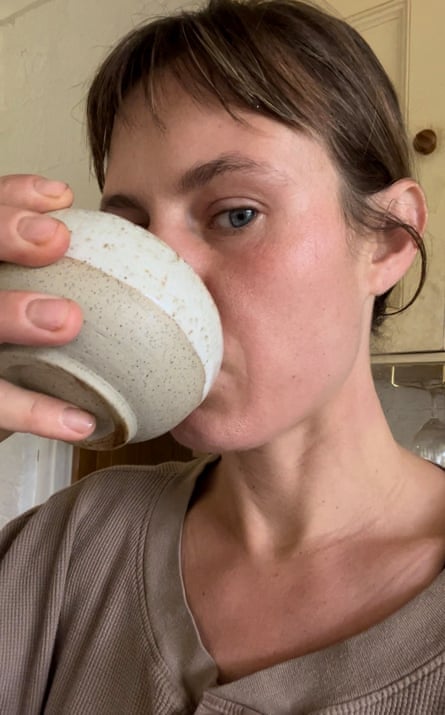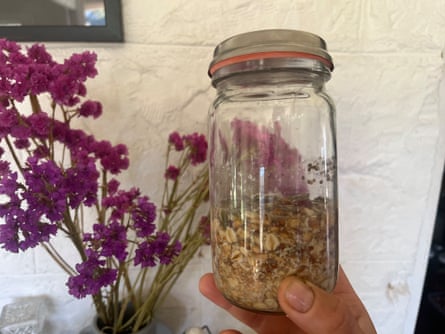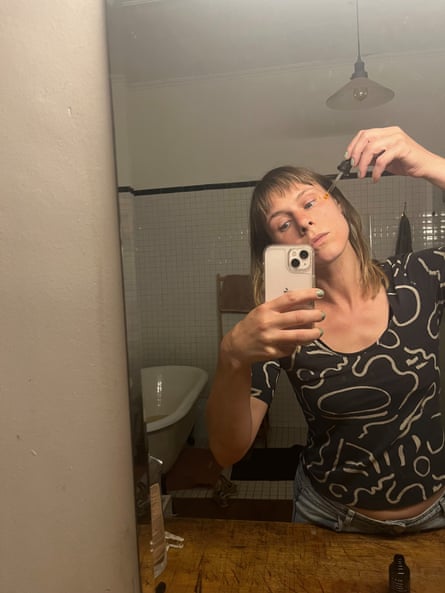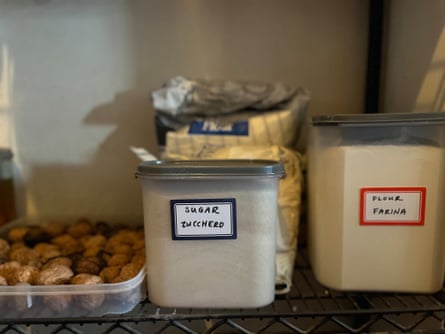
I always considered myself too old for TikTok. A year ago, I downloaded the app, browsed, felt a mixture of horror and fascination, tried to make a video, couldn’t figure it out, and gave up.
But recently, I gave it another look, and what I found both fascinated and confused me: one video after another, creators were slowly and carefully preparing hot drinks – frothy matcha, or pod coffee poured over ice into large, cylindrical jugs, chased with almond milk. These people awoke before dawn to start their day. They all pushed the same puffy headband on to their foreheads, then recited morning affirmations while applying serum and styling their eyebrows. They journaled about their “goals” and planned out their day by the hour. They worked out in spandex sets so fresh that I felt the urge to throw out my old, ratty sports bras. They meditated, and/or practised yoga (both?!). They made smoothies featuring fresh fruit and all sorts of powdered supplements. In some cases, they went on “mental health walks”. And they documented it all.
Why was everyone following a very similar #MorningRoutine and should I be doing it, too? With over 1m videos and 15bn views to the hashtag (and another 37bn on #skincareroutine), there must be something to recommend it.
Routine’s rise and shine
Morning routine videos originated with YouTube, says Prof Crystal Abidin, a digital anthropologist and founder of the TikTok Research Network (TCRN). At the height of the pandemic, TikTok usage soared, and “creators” who had garnered followings by showing off their exciting lives – once filled with events, restaurants and travel – had to rely upon mundane domesticity for content. This is when the “morning routine” genre migrated over to TikTok with force. And with the popularity of that genre, came new opportunities for influencers.
“Morning routine emerged as one of the narrator tools of commercial influencers to promote products in a more natural and casual manner,” Abidin says. “They’d say, ‘here are my favourite products’, and there would be a review.”
“When you frame it as a ‘morning routine’– as if this was something you do spontaneously every day … it gives the impression that you are genuinely a believer and a consumer of these brands,” she adds. This all serves to make product reviews more credible.
Samantha Tannor, a TikTok influencer focused on business and career, says that “morning routine” posts are “one of the most common ways for a lifestyle influencer to build a connection with their followers and to gain new ones”. A morning routine is “low-hanging fruit”. Why? “Every single person on earth wakes up in the morning and has a series of actions that they take in order to get ready for the day.”

In the past two years, says Tannor, the morning routine has become more realistic and attainable. She calls it “the unfiltered morning routine 2.0”. Now, Tannor says influencers are “waking up without a full face of makeup” and sharing less-than-perfect moments. It’s relational rather than aspirational.
I wondered, though, whether branding, or money was the only point of sharing your morning. Jennifer Gallagher, a Florida-based TikToker, says there’s more to it. One of her recent morning routine videos included 10 minutes of journaling “as if you’re living the life you’ve always dreamed of”.
“I choose to film these times occasionally so that I can help inspire others about how important having a morning routine is and also to shed some light on what my routine looks like,” says Gallagher. Documenting quieter moments with the “intent of sharing it in a post” also delivers an “internal push” to be more productive, she says.
Making my first video

An internal push sounded great to me as a busy mother, writer, and winemaker. On a random weekday morning, I made a brave attempt to create my own morning routine video. I set up a tripod and phone in the bedroom, and could not hide my embarrassment in the opening clip. As I fumbled through my regular activities, I wondered if someone would comment on the rustic look of our vintage espresso machine (they did). I worried that nobody would want to see my first-thing-face, unmade and not without wrinkles. But I managed to make a short video. I posted it and closed the app, again telling myself I was too old for TikTok.
As my research continued, a surprising thing happened: new rituals emerged in my morning routine (although I’d put the tripod away). In the evenings, I prepared overnight oats to eat the next morning – sometimes I even had them before coffee, which some TikTokers say reduces the cortisol spike. I started slipping out the door for long solo walks. After watching a few “Sunday reset” videos, in which people spend the morning cleaning and organising their homes, I went out and bought some containers for the dry goods that clutter our pantry. However, I stopped short of putting all my plants in the shower to water them, as @cash_mani does as part of his “Sunday reset” – ultimately, I was too lazy to bother.
Allow TikTok content?
This article includes content provided by TikTok. We ask for your permission before anything is loaded, as they may be using cookies and other technologies. To view this content, click ‘Allow and continue’.
Comedy, commodification and community
I still couldn’t get past the homogeneity: the same headband, the same glass jar and metal straw. It’s likely that some of the repetition was due to TikTok’s algorithm, which inevitably shows us more of the same: accounts that are like us and like each other. But I still wondered why people seemed to use the same products repeatedly. Was this all about influencers getting commission on their Amazon storefront?
In part, it is, says Abidin. But there is more: “We can think of these things as symbols or emblems, loaded with ideology,” says Abidin, using her anthropologist’s approach. Glass jars and reusable straws symbolise wellbeing and self-care as well as environmentalism, as they stand in opposition to disposable versions. However, Abidin notes that it’s easy to “individualise responsibility for climate change and environmental destruction” through such symbolic actions, while forgetting to “ask the hard-hitting questions, [hold] corporations responsible, [get] governments to reduce emissions”. The over-emphasis on conscious consumerism misses the broader point.

Sara Petersen, author of the forthcoming book Momfluenced, points out that some TikTokers do see through the veneer of “morning routine” domestic bliss. She points to a video in which mental health activist KC Davis decries the futility of a perfect morning routine, saying: “You don’t have to wake up before your kids. You don’t have to meditate.”
Petersen says social media encourages the commodification of so many facets of domesticity and parenthood, with “aspirational pantries, aspirational laundry rooms, aspirational after-school snacks, etc”.
What creators like KC Davis show is that these tasks are really just necessary, which makes them “morally neutral,” taking away the need to aestheticise or celebrate them.
All over TikTok, I also found parodies of “morning routine” videos. There was Reece & Sophy’s “Blind Morning Routine Stereotype Edition”, which sheds light on assumptions held by sighted people. I smirked at @emmayoules’ morning in which she sleeps outside so she can wake up and run “three circuits of the globe”.
Allow TikTok content?
This article includes content provided by TikTok. We ask for your permission before anything is loaded, as they may be using cookies and other technologies. To view this content, click ‘Allow and continue’.
Abidin describes parody TikToks as both comical and potentially “flattening” and lacking nuance – the latter, particularly when men mock women’s morning routine videos. “It kind of takes away agency from people,” she says. “It ignores the fact that people are making decisions about how they want to start their day in these videos.”
While routines can be aspirational or artificial, these videos also form part of online community-building, says Abidin. On #CleanTok for example, the morning routine genre helps people connect over ways to tidy a home with a low emotional toll, or while managing attention deficit issues; #MomTok is a space where the genre helps parents connect over best practices while getting their children ready for the day. For people of colour, morning routines often include tips on hair care which can provide a service to other people of colour or, in one case Abidin notes, to educate parents of adopted children.
There is critique as well, in the morning routine genre. Abidin points out videos where dads get their children ready, “normalising the idea of doing your daughter’s hair, getting your son dressed, giving them affirmations in the mirror”, whereas “you’d typically associate these with the mother as the caregiver and it’s refreshing when it’s the dad”.
It turns out that mornings are not so straightforward. They might make a neat narrative package for brands, however it is possible to document routines in ways that push beyond consumption. Perhaps there can be societal critique in our breakfast, our skincare – if we lean away from commerce, and focus on community.


